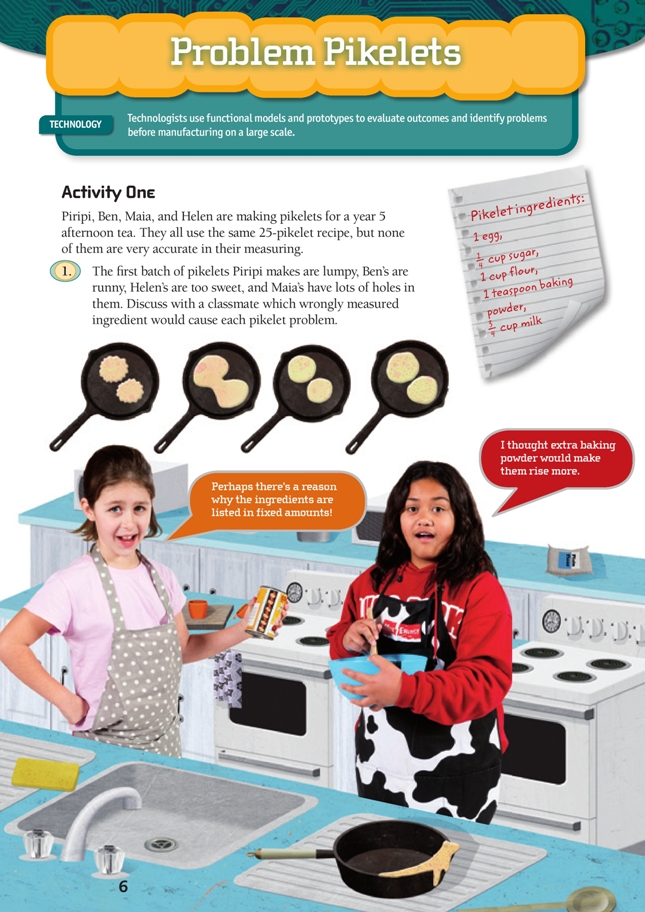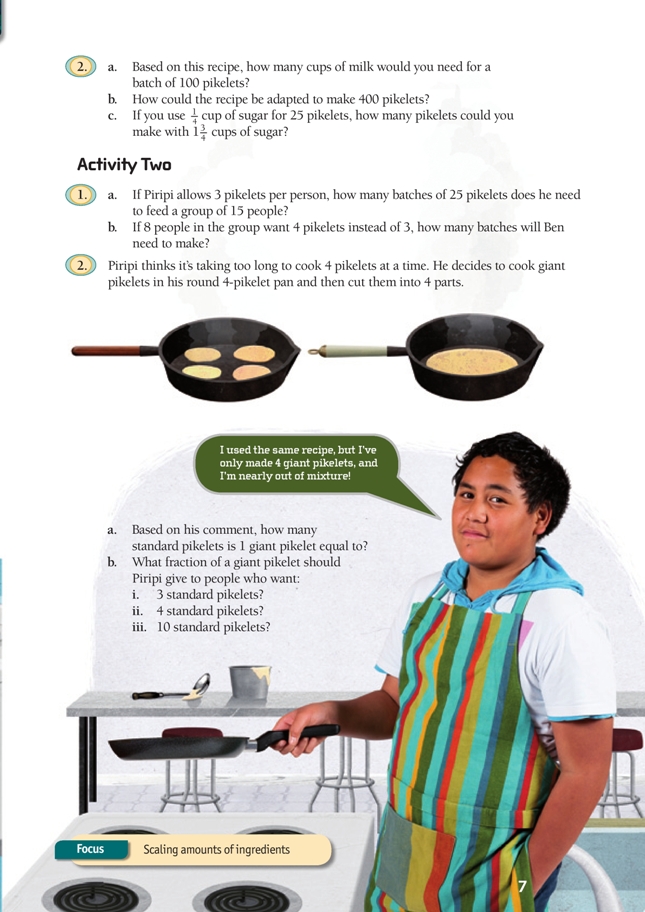This is a level 2-3 activity from the Figure It Out series.
A PDF of the student activity is included.
Click on the image to enlarge it. Click again to close. Download PDF (683 KB)
Numeracy involves developing mathematical skills and knowledge to meet the demands of everyday life. In this activity, students scale up ingredients used in a pikelet recipe. Being able to adapt a recipe to cater for groups of different sizes is a useful everyday skill.
In this activity, students work with fractions and capacity in the context of cooking.
Discuss the mathematics involved in cooking. Some students will have experience of cooking, while others may never have stepped foot in the kitchen except to open the fridge!
Explore the measuring devices that are used when baking. Standardisation of measurement is an important concept. Cups come in a variety of shapes and sizes, but the cup measure referred to in recipes is 250 mL. Measure the capacity of a range of cups and see which is closest to 250 mL. Discuss the role that standardisation plays in cooking but point out that not all cooks or cultures rely on standardised measurements.
Students who struggle to solve fraction problems may benefit from using materials.
Activity One
In question 2, the students need to first work out that to make 100 pikelets you need 4 batches. They can then calculate 4 x 3/4 (rather than finding 3/4 x 100).
A diagram will show how many 1/4 cups are in 1 3/4 cups of sugar.
Extension
Explore metric equivalents of measurements such as teaspoons or tablespoons and use them to calculate equivalences, for example, a teaspoon holds 5 mL and a tablespoon holds 15 mL. How many teaspoons are equivalent to 1 tablespoon?
These activities require students to think flexibly and to discern whether their answers are reasonable, developing the key competency thinking.
Technology-related student activities
It takes skill to read instructions and produce the perfect pikelet, but students involved in food technology should be aware of the purpose behind the activities and be able to modify and trial possible outcomes. Models assist them to make decisions about ingredients, quantities, and production methods.
- Discuss the dietary needs of students in this age group.
- Research commercial responses to particular dietary needs, for example, gluten-free products.
- Research methods and equipment used by commercial food producers, for example, arrange to visit a fastfood outlet.
- Discuss the role of sugar and milk substitutes in baking.
- Research regulations around safety and hygiene. This could be done in tandem with food production for a class or school event.
Exploring the technology-related context
Technologists do not merely follow recipes. They need to modify and trial possible outcomes before going into full-scale production. Scaling up and batch production may produce a range of new considerations. Functional models assist them to make decisions about ingredients, quantities, and production methods.
Answers
Activity One
1. Piripi used too much flour (and may not have mixed his ingredients properly), Ben used too much milk, Helen used too much sugar, and Maia used too much baking powder.
2. a. 3 cups (4 x 3/4)
b. There are several ways to solve this, for example, double the recipe 4 times (25 x 2 = 50 pikelets, 50 x 2 = 100 pikelets, 100 x 2 = 200 pikelets, 200 x 2 = 400 pikelets) or multiply the recipe by 16 (work out how many times 25 goes into 400: 25 x 4 = 100, 100 x 4 = 400, 4 x 4 = 16 times).
c. 175 pikelets. There are 7 quarters in 1 3/4, so you can make 7 batches. 25 x 7 = 175.
Activity Two
1. a. 2 batches. 3 x 15 = 45 pikelets, 2 batches makes 50 pikelets.
b. 3 or 2 batches. 8 x 4 pikelets = 32 pikelets. 7 x 3 = 21 pikelets. 32 + 21 = 53 pikelets. 2 batches makes 50 pikelets, so 3 batches will be plenty. However, the number of pikelets is close to 50, so Ben could make 2 batches and make the pikelets slightly smaller.
2. a. 6. The recipe is supposed to make 25 pikelets. Piripi has only managed to make 4 giant pikelets. 25 ÷ 4 = 6.25.
b. i. 1/2. One giant pikelet is equivalent to 6 small pikelets, 1/2 of 6 = 3.
ii. 2/3 (4/6)
iii. 10/6 or 1 2/3

